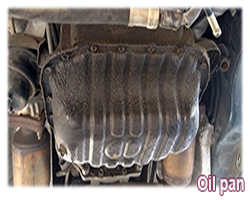
OIL: Describes the liquid that lubricates and cools the moving parts of the engine while reducing the formation of rust and corrosion of bearings, keeps small particles in suspension, reduces engine wear and oxidization.
OIL ADDITIVE: Describes several chemicals that can be added to engine oils to improve their performance, increasing viscosity at high and low temperatures, inhibiting corrosion and preventing the formation of oil oxidation.
OIL BLEED LINE: Describes an external oil line that circumvents the bypass valve to ensure positive oil return to the compressor when RPM is high or the system under a low charge.
OIL BLEED PASSAGE: Describes an internal orifice that bypasses the evaporator pressure regulator to ensure positive oil return to the compressor
OIL BREATHER: Describes a ventilated cap on an oil filler pipe that allows fumes to escape from the crankcase.
OIL BREATHER PIPE: Describes a crankcase breather pipe connected to the crankcase and suspended slightly above the ground used to remove fumes and pressure from the engine crankcase.
OIL-COMBINATION SPLASH AND PRESSURE SYSTEM: Describes an engine oiling system that uses both pressure and splash oiling to accomplish proper lubrication.
OIL CONTROL RING: Describes a piston ring designed to scrape oil from the cylinder wall, designed in a fashion as to allow the oil to pass through the ring and then through holes or slots in the groove.
OIL DRAIN PLUG: Describes the large plug that secures the drain hole in the oil pan, fitted with a gasket to prevent leakage.
OIL DUCT: Describes a passage through which oil can flow under pressure.
OIL FILLER CAP: Describes the cap covering the oil filler hole.
OIL-FULL PRESSURE SYSTEM: Describes an engine oiling system that forces oil into the engine's moving parts.
OIL GALLERY: Describes a pipe or drilled passageway in the engine used to carry engine oil from one area to another.
OIL PAN: Describes the removable cast alloy metal chamber found at the bottom of the crankcase into which the oil drains.
OIL PAN DRAIN PLUG: Describes the bolt that is removed to allow the sump to be drained.
OIL PAN GASKET: Describes the gasket fitted between the cylinder block and the oil pan.
OIL PAN GUARD: Describes the shield fitted under the engine to protect the oil pan when driving on uneven roads.
OIL PICK-UP PIPE: Describes a tube that leads from the filter to the oil pan's oil pump.
OIL PUMP STRAINER: Describes the coarse-mesh metal screen on the bottom of the pick-up pipe that prevents foreign matter (such as lost washers, nuts and bolts) from entering the oil pump.
OIL RAIL: Describes the part of the oil ring responsible for maintaining the seal between the piston and cylinder wall and for the actual "scraping off" of the oil.
OIL SLUDGE: Describes the thick deposit of dirt and the products of combustion, partial combustion and oxidation of the oil that builds up in the oil pan and elsewhere.
All Categories
- Home Page
- Mechanics
Mechanics
Back- Camshaft
- Carburettors A-C
- Carburettors D-F
- Carburettors H-M
- Carburettors R-W
- Clutch B-C
- Clutch D-W
- Cooling System A-C
- Cooling System D-F
- Cooling System H-W
- Crankshaft A-C
- Crankshaft D-W
- Cylinder Head
- Engine A-D
- Engine E
- Engine F-L
- Engine M-S
- Engine T-X
- Filters
- Fuel Control Systems A-E
- Fuel Control Systems F
- Fuel Control Systems M-S
- Gearbox A-D
- Gearbox E-G
- Gearbox H-R
- Gearbox S-W
- Oil Control Systems C-W
- Oil Control Systems
- Pistons
- Auto Electrics
- Brakes,Suspension and Steering
Brakes,Suspension and Steering
Back- Axles
- Brakes A-B
- Brakes E-D
- Brakes FL
- Brakes M-R
- Brakes S-Y
- Differential
- Drive Systems
- Exhaust Systems A-D
- Exhaust Systems E
- Exhaust Systems F-Y
- Hydraulics
- Shock Absorbers
- Springs
- Steering A-R
- Steering S-V
- Suspension A-H
- Suspension I-R
- Suspension S-W
- Tires A-F
- Tires G-B
- Tires S-W
- WheelsA-I
- WheelsI-S
- Wheels T-V
- Bodywork
- Exterior Trim
- Interior Trim
- Paintwork
- Parts and Fittings
- Tools and Equipment
Tools and Equipment
Back 



- Site Map
- Privacy Policy
- Contact Us


All you need to know on how to acquire, restore and maintain a Classic Car
Step back in time to the renaissance age of the UK and European Car Industries
> All that is happening NOW in the world of classic cars.
Step into the golden decade of the UK and European Car Industries
and catch up with all the latest news and features.
Sign up for a Classic Car Info Twitter account.
ae4









